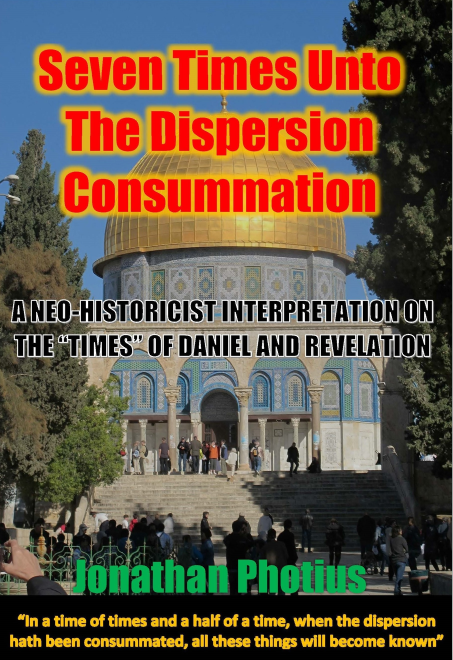
Seven Times Unto the Dispersion Consummation
On Sale
$6.99
$6.99
“In a time of times and a half of a time, when the dispersion hath been consummated, all these things will become known” – Daniel 12:7
Jonathan Photius’s new groundbreaking Neo-Historicism method of interpreting the end-times prophecies offers biblical scholars never-seen-before analysis and a fresh perspective on the Seven-Times prophecies foretelling the punishment and restoration of the Jews.
This book will provide a new study on the prophecies of Daniel and Revelation including:
Neo-Historicism is defined as a new post-modern method of reinterpreting the Apocalypse through a historical lens and perspective. Historicist scholars view prophecy as a continuous fulfillment of events throughout history up until the Second Coming of Christ. Neo-Historicism, however, looks from the second century through the present with a New Eastern Orthodox Historical examination, as compared to the more traditional Protestant-based Classical Historicism interpretations published from the 16th-to-19th centuries which tended to focus more of a Western European-only view of events in history centered around the Protestant Reformation. The Neo-Historicist method presents a logical alternative to the Futurism and Full Preterism schools of thought for interpreting apocalyptic prophecy.
Historicist views were more common after the dawn of the reformation in the West with the printing of the first English bibles in the 16th century. Historicist views exploded in the 17th and 18th centuries. However, by the mid-19th century, Preterism and Futurism gained significant momentum, which promoted the idea that all prophecy was either fulfilled by 70 AD, or remains to be fulfilled still at some point in the future. The Classic Historicist view also lost significant popularity and momentum after William Miller’s failed 1844 AD prediction of the second coming of Christ, often called the Great Disappointment. Even still, the Historicist view should be revisited once again by biblical scholars, with a new appreciation after the recent failures by many Evangelicals who attempted (and failed) to predict the exact date of the “rapture,” and with a fresh perspective now that we can examine the events of the middle east crisis in the past 20th century.
This new Historicism model offers the reader a logical solution to interpreting biblical prophecy. No other prophetic method of interpretation (specifically Preterism and Futurism) offers the same level of authenticity with proven calculation and confirmation of dates and events with fulfilled events in scripture as Neo-Historicism. The other notable benefit of the Neo-Historicist perspective is that it also offers a more Christological-centric view of the Book of Daniel and St. John’s Apocalypse. Centered around the nature of Christ as the God-Man, Neo-Historicism demonstrates the biblical foretelling of the rise of every major heresy that challenged the One Holy Catholic and Apostolic Church for the last 2000 years.
Jonathan Photius’s new groundbreaking Neo-Historicism method of interpreting the end-times prophecies offers biblical scholars never-seen-before analysis and a fresh perspective on the Seven-Times prophecies foretelling the punishment and restoration of the Jews.
This book will provide a new study on the prophecies of Daniel and Revelation including:
- The Seven Times Punishment and Restoration of the Jews
- The Convergence of the Northern & Southern Kingdoms’ Return
- Re-examining Daniel’s 70-Weeks prophecy alternatively as 70- Generations of Jewish Diaspora with a 69th-Generation Return.
- The Crucifixion, Holy Eucharist and Holy Trinity revealed through Daniel’s 70-Weeks Prophecy with a 30 A.D. death on the cross.
- Weakness of Seder Olam Rabbah vs Conventional Chronology
- Handling common objections and lies promoted by Jewish rabbis with the 70-Weeks Prophecy identifying Christ as fulfillment.
- The Birth of the God-Man through the Ecumenical Councils
- A revised calculation for the 2300 days of Daniel 8
- The Rise and Fall of Islam foretold in the scriptures
Neo-Historicism is defined as a new post-modern method of reinterpreting the Apocalypse through a historical lens and perspective. Historicist scholars view prophecy as a continuous fulfillment of events throughout history up until the Second Coming of Christ. Neo-Historicism, however, looks from the second century through the present with a New Eastern Orthodox Historical examination, as compared to the more traditional Protestant-based Classical Historicism interpretations published from the 16th-to-19th centuries which tended to focus more of a Western European-only view of events in history centered around the Protestant Reformation. The Neo-Historicist method presents a logical alternative to the Futurism and Full Preterism schools of thought for interpreting apocalyptic prophecy.
Historicist views were more common after the dawn of the reformation in the West with the printing of the first English bibles in the 16th century. Historicist views exploded in the 17th and 18th centuries. However, by the mid-19th century, Preterism and Futurism gained significant momentum, which promoted the idea that all prophecy was either fulfilled by 70 AD, or remains to be fulfilled still at some point in the future. The Classic Historicist view also lost significant popularity and momentum after William Miller’s failed 1844 AD prediction of the second coming of Christ, often called the Great Disappointment. Even still, the Historicist view should be revisited once again by biblical scholars, with a new appreciation after the recent failures by many Evangelicals who attempted (and failed) to predict the exact date of the “rapture,” and with a fresh perspective now that we can examine the events of the middle east crisis in the past 20th century.
This new Historicism model offers the reader a logical solution to interpreting biblical prophecy. No other prophetic method of interpretation (specifically Preterism and Futurism) offers the same level of authenticity with proven calculation and confirmation of dates and events with fulfilled events in scripture as Neo-Historicism. The other notable benefit of the Neo-Historicist perspective is that it also offers a more Christological-centric view of the Book of Daniel and St. John’s Apocalypse. Centered around the nature of Christ as the God-Man, Neo-Historicism demonstrates the biblical foretelling of the rise of every major heresy that challenged the One Holy Catholic and Apostolic Church for the last 2000 years.
